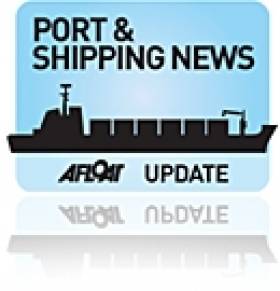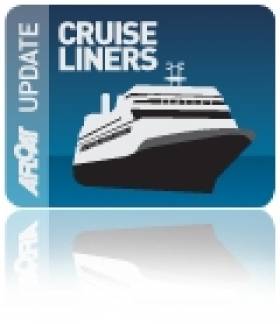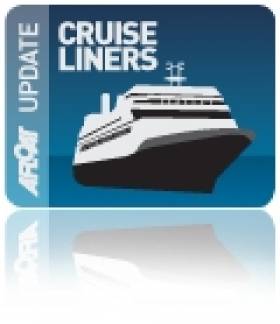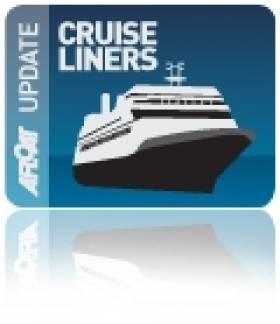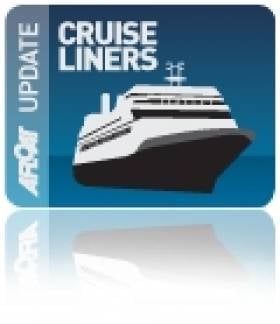Displaying items by tag: Cruiseliners
#PORTS & SHIPPING REVIEW – Dublin 'Docklands' floating river-restaurant ship M.V. Cill Airne celebrated her 50th anniversary having been built nearby at the Liffey Dockyard. A special lunch and lecture organised by the Cobh branch of the World Ship Society was held on board the veteran vessel which represents one of the last surviving ships built in Ireland and which remains around our coast having had a rich and varied career.
Along the Shannon Estuary the mid-west port of Foynes welcomed the first cruise call for this year with the arrival of the 28,000 tonnes ultra-luxury Silver Whisper. Passengers from the 382 capacity cruiseship toured the region including the local Foynes Flying Boat Museum.
Returning to the East coast where in Drogheda Port, onlookers welcomed the first ever scheduled cruise call to the Boyne when the Clipper Adventurer berthed at the Co. Louth port to complete a circumnavigation cruise of the island where US and Canadian passengers disembarked.
Down the coast the RV Keary was undergoing refit at Arklow Marine Services yard. The research vessels owners Geological Survey of Ireland (GSI) have chartered the Cosantoir Bradan from the Central Fisheries Board for survey work to assist the RV Keary.
In the capital the veteran grab-hopper dredger Hebble Sand (1963/757grt) departed Dublin Dry-Dock facility in readiness for a new career working with Northern Ireland based Abco Marine. The former Dundalk Port Company owned vessel which resembles the last of the Guinness ships, currently remains in the port awaiting her first delivery voyage for contract project work.
Across the Irish Sea the first of two new offshore patrol vessels (OPV) for the Naval Service had its keel-laid at a ceremony at Babcock Marine's shipyard in Bideford, north Devon. The €99m pair are an enlarged version of the 'Roisin' class L.E. Roisin (P51) and L.E. Niamh (P52) which were launched from the same UK yard over a decade ago then owned by Appledore Shipbuilders.
Twiggy’s Cruiseship Calls to Town
#COBH CRUISE CALL – The sleek profile of Seabourn Sojourn, the cruiseship whose godmother is Twiggy, the English fashion icon and actress, called at Cobh Cruise Terminal this morning, writes Jehan Ashmore.
The ultra-luxurious vessel is the second of a pair of 32,000 tonnes sisters built for Seabourn Cruises by Italian shipyard T. Marrioti in Genoa. She was launched into the Ligurian Sea in 2010 and unusually for a cruiseship she has twin funnels that skilfully merge into the superstructure's appearance.
In the same year the 197m vessel made a promotional visit to London where she was christened by Twiggy at a ceremony held on the Thames.
Seabourn Cruises operate in the top end of the cruise market and have won prestigious travel awards over the years. Likewise to competitor Silverseas Cruise whose Silver Whisper is visiting Killybegs today having made a port of call to Foynes yesterday.
The 450 guest capacity Seabourn Sejourn is also in the same league with her rivals in that she only has suites in terms of accommodation type, where within there is a choice of six categories.
She has 225 ocean view suites measuring 295 to 1,682 sq ft, 90% with private verandas. This includes five Owner's Suites measuring up to 1,062 sq ft (including the veranda) and four two-bedroom Grand Suites with up to 1,682 sq ft of private living space.
In addition there are 22 Penthouse Suites on the uppermost decks, each featuring up to 534 sq ft feet of space. To browse a virtual tour of these very spacious suites on Deck 11 click HERE.
As for facilities she sports the largest spa on any ultra-luxury ship, at 11,400 sq ft encompassing an indoor and outdoor space laid out over two decks. There are also six whirlpools and two swimming pools, including the pool patio, with a pair of large whirlpool spas and a "beach" style pool, a casual patio grill and the patio bar.
On the sun deck above sits Seabourn's popular open-air Sky Bar located high atop on deck 11 is a Sun Terrace with 36 tiered double sun beds. Just aft of that is The Retreat, with shuffleboard courts and a nine-hole putting green.
The panoramic Observation Bar on Deck 10 offers 270 degree forward views over the sea. There is the Club for dancing and the larger Grand Salon is also used for dancing as well as lectures, production vocal shows, cabaret performances and classical recitals.
Other facilities can be viewed through the virtual tour HERE
Silverseas Sails to Shannon Estuary
#SHANNON SILVERSEAS - The mid-west port of Foynes is playing host to the ultra-luxurious Silver Whisper (2001/28,000grt) which docked along the Shannon Estuary this morning, writes Jehan Ashmore.
The vessel operated by Silverseas Cruises had sailed from Southampton and at least another call by another vessel is also scheduled this season. On average the Shannon Foynes Port Company handles four cruise calls each season.
One of the main visitor attractions along the Shannon is the local Foynes Flying Boat Museum, which retraces an altogether different era in transportation, yet also carried out travel in style when the B314 flying boats used the Co. Limerick terminal between1937-1945. Then the trans-Atlantic travellers spent time at the Foynes hub-terminal which also became home to the 'Irish Coffee'.
On board the 382 passenger capacity vessel she has a near equal number of crew at 302. This passenger to crew ratio is exceptionally high and reflects her status in the very top end of the cruise travel market. Silverseas have over the years won a whole string of globally recognised travel industry awards.
All accommodation on board the 186m / 610ft long vessel is based in suites cabins (available in seven grades) with each featuring a balcony of ocean views and countless destinations.
Facilities include boutique shopping; a wellness spa with beauty salon, fitness centre and sauna; full-scale productions in a multi-tiered show lounge; a casino, an internet café and Wi-Fi service. To read the full range of facilities and virtual tours click HERE.
In 2012 the Silver Whisper cruising schedules are to Brazil then to South Africa and the Indian Ocean landscapes. Beyond that she heads for the South China Sea, west to the Arabian Sea and Egypt.
During the summer she explores Europe before arriving in Canada for autumn's vibrant 'fall'. Silver Whisper's globetrotting culminates in the Caribbean with cruises through the year's end.
Quest for Adventure finds the Foyle
#CRUISE CALLS – The opening cruiseship caller for this year in Londonderry was marked by the arrival this morning of the 446 passenger Quest for Adventure, writes Jehan Ashmore.
She docked at Lisahally, downriver of the north-west city, having sailed overnight from Dublin Port. The 18,000 tonnes vessel is also operating on her first season for UK based Saga Cruises.
A further seven cruise calls are scheduled this season, noting each visit will be taken by individual ships as there will be no repeat calls. Since 1995 the Foyle have welcomed these vessels.
Asides Lisahally, they can also berth at the city-quays or at anchorage off Greencastle, Co. Donegal.
Cruise Callers to Dun Laoghaire ‘Recalled’
#DUN LAOGHAIRE CRUISELINERS – The recent call of what is believed to be the world's smallest cruiseship the Quest (1991/1,180grt) to Dun Laoghaire Harbour as part of an initiative to develop this sector is by no means completely new to the harbour, writes Jehan Ashmore.
It was not until a decade ago that the last cruise callers were on the scene, albeit making infrequent visits and they also varied considerably in size. Among the callers was the famous 'Cunarder' Queen Elizabeth 2 or 'QE2', RCCL's Norway formerly French Line's France and Celebrity Cruise then brand new Constellation. Notably these large vessels all made anchorage calls in Dublin Bay.
Constellation made this call in 2002 as did the Sun Bay II which was also then recently launched into service and the cruiseships were making their debut season in European waters. They could not be so different, the 2,800 tonnes Sun Bay II with an 89 passenger capacity in complete contrast to the 90,000 tonnes Constellation with over 1,800 passengers.
The diminutive Sun Bay II was not too dissimilar to Noble Caledonia's Quest in terms of passenger capacity being slightly smaller with a capacity of 52. She was alongside Carlisle Pier where her guests were on a 9-night Garden themed cruise of UK and Ireland that included tours to Powerscourt and Mount Usher in Co. Wicklow.
On the call of Constellation she anchored relatively closer to the shore off Bulloch Harbour, compared to QE2 and Norway's calls and she presented an imposing and impressive sight.
In the case of the Norway, her passengers were ferried to the marina by unusually large tenders more akin to tank landing craft as they bow doors (click PHOTO). In fact they were so large that they could not be stowed on the lifeboat deck and instead located forward of the bridge where deck-mounted cranes were used for hoisting operations.
The practice of anchorage calls will continue as vessels of this size will remain too large to be accommodated in the harbour in the short term, though the Dun Laoghaire Harbour Company's 'masterplan' includes a proposed €18m new cruise terminal. They claim the terminal would be capable of handling the largest and most modern cruiseships in the world.
In the meantime the landing point for tenders to use a new tender dock facility was installed recently at the Traders Wharf, as distinct to the Carlisle Pier (site of proposed Diaspora Museum) where small to medium sized vessels are to berth.
A further three more calls are scheduled this season, including a return call next week of Quest and other vessels capable of carrying around 500 passengers. This figure is to rise considerably in May 2013, thanks mostly due in part to the massive Cunard Line flagship Queen Mary 2 (QM2). The 151,400 tonnes 'liner' can take over 2,600 passengers and 1,200 crew alone.
With the visit of QM2, this is to be her fist call to Dublin Bay, as she is still to be big even for Dublin Port to handle. Likewise the rivals across Dublin Bay in the Dublin Port Company are proposing as part of their masterplan to build a €30m dedicated cruise terminal. This facility would also be able to accommodate very large cruise callers.
It will be interesting to see how both completing ports progress and how they market themselves to the cruise sector industry, no doubt across the board. The giant ships look after large volumes which keep cruise prices down. As for the smaller boutique style of cruiseship operators, they can command higher prices by targeting the top end of the market and where they have higher-spending power at ports of call . The cruise industry overall is becoming increasingly more globalised where it was traditionally the preserve of the European and North American markets.
Arguably it is debatable if there should be two cruise terminals built as it reminiscent of the controversary during the '80's over the battle between which Dublin Bay port would be chosen for the site of a new single dedicated multi-user car-ferry terminal.
As it transpired the ferry service to Holyhead remains operating out of Dun Laoghaire Harbour, where a new terminal was built specifically to dock the revolutionary design of the HSS (High-speed Sea Service) fast craft catamaran car-ferry. Albeit in recent years the route's sailing frequency has reduced considerably. Under the last contract between Stena and the harbour company, this has led to considerably less revenue generated in harbour dues. The HSS Stena Explorer currently maintains only a single daily round-trip and only on a seasonal basis between April-September.
While at Dublin Port a multi-user ferry terminal was built but Stena Line did not immediately become part of the facility. It was not until 1995 that they set up an additional new service from Dublin Port to Holyhead. They use a second adjacent terminal that is currently served by two ferries on the company's second route to Wales.
Calling Cherbourg: All Things Nauting
#FERRY SAILS – Ferry passengers perhaps on a mini-wine break cruise between Rosslare-Cherbourg may be taking a detour to the Cherbourg Nauting Boat Show which is been held this weekend, writes Jehan Ashmore.
Both Celtic Link Ferries and Irish Ferries operate on the continental route to the man-made Norman port originally constructed by Napoleon. The present day bustling town-centre of Cherbourg-Octeville to give its full name is close to the large 1500-plus berth marina at the Port Chantereyne which is hosting the show.
Those attending can buy and sell new and second-hand boats and where there will be exhibitors attending the three-day show which started yesterday. Activities include scuba-diving, dry surf, stand-up-paddle and model-boats on a dedicated pool.
In addition there is a guided-tour on a racing-boat commented by its skipper Eric D'Hooghe from the Figaro Race. Also making an appearance is the French rower Rémy Alnet who will be there to talk about his trans-Atlantic races.
Also on a related note is the La Cité de la Mer which is a museum situated in the former trans-Atlantic liner passenger terminal used during the so called golden era. The history of these liners is recalled in the museum and of course includes the RMS Titanic and the French Line's famous France which as the Norway made a once off anchorage call outside Dun Laoghaire Harbour.
In addition there are displays of submarines including the decomissioned French Navy nuclear-powered submarine Le Redoutable which is located in an adjoining dry-dock.
- Ferry news
- Cherbourg Nauting
- Napoleon Port of Cherbourg
- Port de Cherbourg
- Cite de la Mer
- CherbourgOcteville
- RosslareCherbourg
- Port Chantereyne marina
- Celtic Liink Ferries
- Irish Ferries
- WineBreak Mini Cruises
- Scubadiving
- DrySurfing
- standup paddle
- SUP
- ModelBoats
- New Boats
- SecondHand Boats
- TransAtlantic Liners
- Le Redoutable submarine
- French Navy
- RMS Titanic
- French Line's France
- Cruiseship Norway
- Dun Laoghaire Harbour
- Dun Laoghaire Harbour cruise liner calls
- Dun Laoghaire Harbour Norway anchorage call
- Cruiseships
- Cruiseliners
- Figaro Race
- Eric D'Hooghe
- French rower Remy Alnet
- Remy Alnet
- La Cité de la Mer
Mega-Yacht Cruiseship Returns
#MEGA-YACHTCRUISESHIP – Nearly a year ago to her Irish debut the Le Boréal a mega-yacht cruiseship called to Dublin Port today, writes Jehan Ashmore.
The sleek sweeping lines of the 132 berth and 264 maximum capacity vessel is designed with French flair by Jean-Philippe Nuel and built with Italian expertise by Fincantieri. She is scheduled to depart from the capital tonight. For more information and photographs of the ship, click HERE.
When she entered service for Compagnie du Ponant, the only French cruiseship operator won for the Best New Ship of the Year 2010. The prize was rewarded by the European Cruiser Association for more visit www.eucras.com
Cruise Call Opens New Opportunities for Dun Laoghaire Harbour
#CRUISE CALLS - The docking of the Quest in Dun Laoghaire Harbour this morning marks the first phase of cruise calls this summer as part of a new development to attract cruiseships, writes Jehan Ashmore.
The opening of the cruise sector business which formed part of the Dun Laoghaire Harbour Company's Masterplan is seen as a significant boost to the local economy considering the declining operations of the HSS fast-ferry service in recent years.
The Quest which is operated by Noble Caledonia is on a 9-night 'Garden' Cruise of the UK and Ireland, where prices started from £3,295. She berthed at the Carlisle Pier where for many generations passengers boarded the mail-boats followed by the conventional ferry to Holyhead which last left the route in 1996.
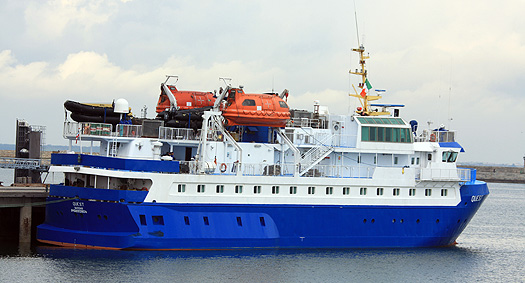
Quest along side in Dun Laoghaire. She carries 50 passengers
At just under 50m long the Quest carries only 50 passengers though this number is set to increase when a further four cruise calls are scheduled this season with larger vessels capable of carrying around 500 passengers.
Cruiseships Head for Isle of Man
#MANX CRUISE CALLS – The Manx capital is set to welcome over a dozen cruise callers for the season which starts next month according to www.visitisleman.com
Two of the 14 calls that are scheduled to Douglas belong to the Silversea Cruises fleet, the Silver Cloud due in June, has been a fairly frequent visitor to the Isle of Man in the past. While the company's recently acquired 'Expedition' vessel Silver Explorer will be visiting the Island for the first time earlier in May.
Other distinctive inaugural callers in 2012 include the Seven Seas Voyager. The Berlitz Guide rated luxury premium class vessel is also scheduled to visit Douglas again the following year.
In addition to the 2012 season, the Thomson Spirit is due to call in early September, a vessel with a 1,250 passenger capability.
Below is the 2012 cruise call list
Quest for Adventure, 8th May
Arion, 26th May
Discovery, 28th May
Silver Explorer, 31st May
Marco Polo, 4th June
Ocean Countess, 5th June
Seven Seas Voyager, 7th June
Silver Cloud, 8th June
Saga Sapphire, 4th July
Quest for Adventure, 9th July
Marco Polo, 16th July
Deutschland, 20th July
Hebridean Princess, 21st August
Thomson Spirit, 6th September
‘Lost Weight’ Cruiseship to Call to Dublin Port
#CRUISE LINERS – Following Friday's first cruise call to Dublin Port this year of the 300-plus passenger Arion as previously reported, the considerably larger Grand Princess is to call on Wednesday. Notably on this occasion the 2,600 passenger cruiseship is to appear without her signature 'Skywalker' Nightclub, which used to be perched 18 decks-high at the aft of the vessel, writes Jehan Ashmore.
The aptly named nightclub was built on two legs to form a bridge (see PHOTO) and was accessed by a glass gangway. Not only was the structure at such an elevated position but it also overhang beyond the sheer of the stern superstructure below, where clubbers had bird's eye views over the oceans and to numerous ports of calls.
In an operation to remove the Skywalker last year, the structure weighing 211 tons took over 10 hours to complete (as previously reported including VIDEO of the work). The reason for removing the nightclub according to her owners Princess Cruises was to 'significantly improve the operational performance of the ship, including greater fuel efficiency.' For a post dry-docking view click PHOTO.
During the procedure at the Grand Bahama Shipyard in the US, the opportunity included the installation of a new nightclub three decks below and was named One5.
Ironically before the vessel lost weight!....she was the first cruiseship to visit Dublin Port to surpass the 100,000 tonnes milestone, when the leadship of the 'Grand' class docked in 2004.


























